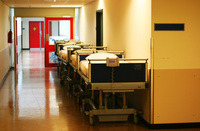In-hospital death rates go up as hospitals fill up, University of Michigan researchers find

When hospitals are already almost full with patients, their in-hospital death rates appear to increase, according to a new study from University of Michigan researchers.
Other factors like nurse staffing levels, whether someone was admitted on the weekend and whether the hospital was in the thick of the seasonal flu season also impact in-hospital death rates.
It is the first study of its kind to look simultaneously at the four different factors of in-hospital mortality and find independent and "statistically significant" impacts on death rates.
For instance, being admitted to the hospital when it's almost already full can increase the risk of dying in that hospital by 5.6 percent. When nursing staff levels were increased, that risk decreased by 6 percent.
But being admitted on the weekend increased the risk of in-hospital death by 7.6 percent, and being there during peak periods of influenza spread could increase in-hospital death risk by nearly 12 percent.
"This study further establishes each factor as a major predictor of hospital deaths, but the good news is that each can be modified in some way," said Darrell Campbell Jr., a co-author and chief of clinical affairs at the U-M Health System.
U-M Health System's Peter Schilling, a resident in orthopedic surgery, and Matthew Davis, co-director of the Robert Wood Johnson Foundation Clinical Scholars Program at U-M, also co-authored the study. It was published in the March edition of Medical Care.
The researchers looked at records from 166,920 adult patients admitted to 39 hospitals in Michigan between 2003 and 2006. Those patients were all 65 and older who had been admitted through the emergency department at the hospital with one of six common diagnoses of heart attack, congestive heart failure, stroke, pneumonia, hip fracture or gastrointestinal bleeding.
The study controlled for patient age, gender, discharge diagnosis and other diseases.
According to a release, the study shows the phenomenon of "access block," which occurs when patients in the emergency room must wait for care because they can't access an inpatient hospital bed.Â
Because it is impossible to predict when there might be a sudden rush of accident victims, the authors said, administrators could control occupancy levels by managing the number of elective surgery cases they schedule at one time for admission. That is a move that could cost hospitals money.
"However if access block is a true phenomenon, a hospital full of elective surgical admissions may be limited in its ability to safely handle an influx of urgent admissions through the emergency department," Schilling said in the release.
The findings may help guide administrators to consider seasonal and weekly patterns in "patient flow and capacity, as well as staffing," according to an abstract of the study.
Tina Reed covers health and the environment for AnnArbor.com. You can reach her at tinareed@annarbor.com, call her at 734-623-2535 or find her on Twitter @TreedinAA.


Comments
Ruth
Wed, Mar 10, 2010 : 1:52 p.m.
I don't think the result was obvious and believe it was logical to look at those factors. Re the idea of increasing nursing staff rather than doctor staff, patients are basically in the hospital to receive nursing care. The doctor does surgery for an hour or more, but the rest of the time is recovery and healing from nursing performed treatments and care, etc. Once insurance administrators realized that patients were in the hospital to receive nursing care, they pushed to earlier and earlier discharge and loaded up the patient's family to provide care that had always been done in the hospital. This has been done to the detriment of some patients and their families.
David Paris
Tue, Mar 9, 2010 : 9:58 p.m.
So then, there must be a minimum threshold for Patient:Nurse ratio? How would we go about making sure that that threshold is met?
Bridget Bly
Tue, Mar 9, 2010 : 9:36 p.m.
It's not as obvious as it sounds. It could have turned out that patient load made no difference in fatality rates, as long as the hospital wasn't actually over capacity -- and we all would have said, "that is so obvious, why was that study even done?" It's interesting that the fix for too many patients is increasing the *nursing* staff, not the doctors.
treetowncartel
Tue, Mar 9, 2010 : 9:11 p.m.
Don't forget a lot of people put off going to the ED until after church is over on Sunday.
jeefy
Tue, Mar 9, 2010 : 8:44 p.m.
Maybe I'm too jaded, but I really dislike seeing money spent on verifying something as obvious as this. Next, we'll be stating that the colder it is, the more likely water will freeze.
Lokalisierung
Tue, Mar 9, 2010 : 6:12 p.m.
More sick people to contaminate already sick people casues more people to get sicker; got it. Whew, thankfully we have studies to tell us these things.
voiceofreason
Tue, Mar 9, 2010 : 6:12 p.m.
Oh no! We must socialize the entire health care system immediately! Government is the only entity that can solve this problem!